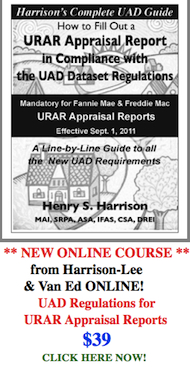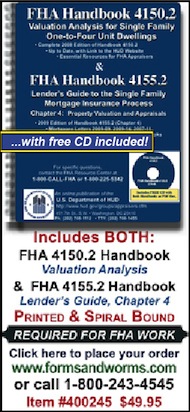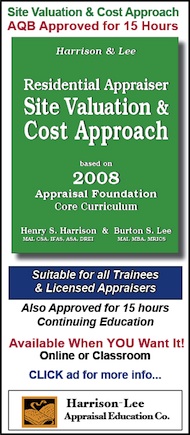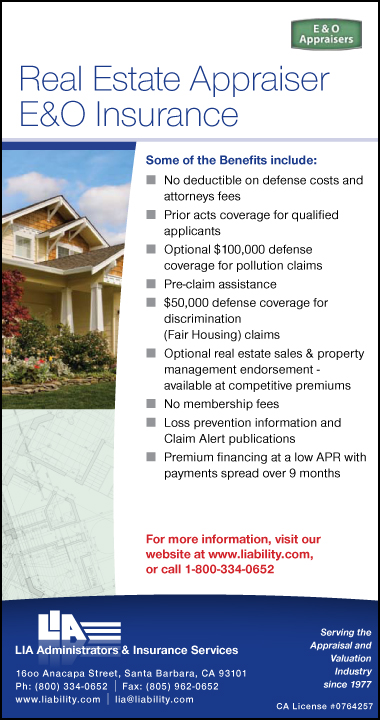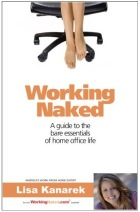Ask Henry
Dear Henry,
A larger appraisal management company is now requesting that the comp photos be recent to the season in which the appraisal is being completed. If a home is being appraised in the summer, they do not want comparable photos with snow or fall colored leaves on them.
How many times can an appraiser afford to retake old comp photos with gas at $3.15 a gallon, never mind the time consuming effort of going there in the first place. Some of my comps are in rural areas where each one could be 20-30 miles away from the other.
Is this a legal and legitimate request?
Jean Black
jeanblack@echoes.net
Dear Jean,
Often AMCs do not realize that their requests substantially increase the appraiser's costs. The USPSP requires that you have a scope of work dialogue with the lender/client. Unless something they requests conflicts with the requirements of the USPAP they are not in my opinion illegal or illegitimate. You really have four choices as to what to do. 1. Try to talk them out of the requirement. 2. Tell them that it requires extra work for which you expect extra pay. 3. Do what they request. 4. Refuse to do the assignment.
Ask Henry
Dear H2,
I have been a Realtor for 25 years. I am not a broker. I have recently taken a job with the County as a property tax assessor in training.
The assessor job offers benefits, steady employment etc. I thought I could give up Real Estate sales, but it is not that easy after 25 years. I could see where there would be situations where I would have to morally (if not legally) recuse myself, but for the life of me, I cannot see why I cannot help people to purchase a home after hours or on weekends -- just like a Realtor/Broker can appraise property, do CMAs, and then help someone to buy that same property. Disclosure would have to be made of course. I just started as an Appraiser Trainee, and will be going to CPE classes to get my license. I will have to make a decision soon as to my staying with the Assessor Position. The extra income from Real Estate sales is important to my family.
Is there any conflict of interest, if I wanted to do property assessing full time, and still sell real estate part time?
Dear Mike,
This problem has come up many times before. Many municipalities will not permit someone like you to "wear two hats". However, some do. It is all a matter of "appearances" -- and with assessors it is especially a problem. Many people do not like their tax assessments and think their neighbors got treated better because they had some kind of connection to the assessor. If you decided to do this work, you must get written permission from the municipality for which you will be assessing.. Even then it is not 100% safe. Your reputation may suffer.
Editorial
It is my opinion that we are going to have some inflation in the United States shortly, and that this will be a good thing for the economy — and especially good for real estate.
I believe inflation is the inevitable result of the monetary and fiscal policies of the past year and those projected for 2011. Budget deficits have been growing dramatically, in absolute terms and as a percentage of GDP, and for the most part up to now they have not been financed with newly printed money. Instead, the deficit has been financed primarily with Treasury Bonds sold to foreign investors (China being by far the largest).
By announcing its plan to inject $ 600 billion into the economy by buying up Treasury Bonds to support the recovery and boost prices, the Federal Reserve Bank has unleashed a near-certain inflation. Fed Chairman Ben Bernanke has reiterated that the Fed is prepared to buy even more Treasury bonds over the next eight months, to continue the "economic easing" he began last month.
The simple fact is that this amounts to the Fed printing $600 billion dollars of paper money. Anyone who has taken an economics course knows that printing paper money causes inflation. That said, a modest inflation should be welcomed by those in the real estate industry.
“...a modest inflation should be welcomed
by those in the real estate industry."
A reasonable rate of inflation is good for real estate. The magic of real estate has historically been that you could invest in real estate (a home or investment property) with a small down payment, and borrow the balance with a long-term mortgage. Wise investors know that the mortgage must be at a fixed interest rate. Then, if inflation occurs (as it has for many decades), the investment appreciates in value.
Here is an example of how the magic of real estate investments works when there is a reasonable amount of inflation. Say the purchase price of a property is $300,000. The buyer puts down 10% of the purchase price, or $30,000. They get a mortgage on the remaining $270,000. In this example, the cash investment was $30,000. If there is an inflation of 3% a year, in just 5 years the property will be worth $345,000 ($300,000 x 115%) and the investor will have made $45,000 -- a 150% return on their initial $30,000 investment.
Of course this example is an over simplification, as it does not consider many other factors that may affect the value of the property, but it does explain why real estate has been a great investment when a small but reliable rate of inflation is operating in the economy.
Psychologically, moderate inflation stimulates spending, and lowers the real cost of paying off long term debt (you can pay off your mortgage using inflated dollars which are of lower value).
A nicely timed moderate inflation is, in my opinion, what will get us out of this slump! Hats off to Ben. I think he's made the right decision at the right time.
Ask Henry
Hello Henry,
I am developing a retrospective field review with an opinion of value for investigative purposes. The effective date is 4-1/2 years prior and the subject and all (three) comparables were investor rehabs/resales in an economically distressed neighborhood, with price increases of 50 - 60% within 3-9 months.
The main issue with the report under review is data verification and the credibility of the comparables' cash equivalent sales prices. Primarily, no 3rd party verification sources were cited and it does not seem that financing concessions were properly verified or adjusted for if they did exist. Seller-assisted financing was common in the market at that time. Most weight was given to Sale #1 which did not have an MLS listing. Sale #2 had a potentially unsupported 8%+/- upward condition adjustment for 'avg' vs 'good' condition; this sale had a "blank" listing #, but also had a 60% price increase within nine months, indicating that it may have rehabilitated in a manner similar to the subject. My research has revealed two sales that support the original value that have no MLS listings; and other "blank" MLS listings that appear to have been investor rehab/resales. I cannot verify these sales or the conditions of the sales in the normal course of business after an elapse of 4-1/2 years. Is it acceptable to use these sales in developing my OMV with the extraordinary assumption that they had no sales concessions that affected their prices? Or by using these unverifiable sales would I be committing the same poor practices found on the original report i.e., the pot calling the kettle black??
Thank you for your time,
Michael A. Ciaccio
Certified Residential Appraiser RD6539
macappraisals@gmail.com
Dear Michael,
I can only give you some general advice, as it is my policy not to comment on specific appraisals.
- It is up to the appraiser to select the most comparable sales. There are no USPAP restrictions on how this is done.
- It is up to the appraiser to make whatever adjustments are needed, keeping in mind that using unsupported adjustments can lead to trouble as the USPAP requires that the appraisal be credible.
- The USPAP has specific instructions about using "Extraordinary Assumptions" (2010-11 USPAP U-3 & U 18). From what you say, they may be appropriate in this instance. Be sure to follow the disclosure requirements.
- You must decide if your report is credible. If there is a reasonable doubt in your mind about its credibility, you should not make the appraisal, as it would violate USPAP to do so.
Rave
What a pleasant surprise to see email from REV magazine this AM...Like a long lost friend, I've always been happy to hear from Henry and enjoy his easy-to-comprehend take on the appraisal industry. I believe I have most every copy of REV magazine in my library and printed articles from the more recent web versions. He has the gift of getting his thoughts on paper in a way that is easily absorbed.
Happy Belated 80th Birthday and I look forward to your blog entries.
Best Wishes!
Julie Mathewson
julie@mathewsonappraisal.com
Ask Henry
Hello Henry,
It appears that some lenders are requiring an estimated economic life on all appraisal reports (even for 1073 form reports on Condos). I understand that banks are using this to determine if the life of the loan exceeds the economic life of the subject. The problem is that economic life is dependent on the owner's maintenance. If, say, a new owner doesn't have the funds and/or knowledge to repair a roof leak or get rid of termites, the economic life could easily go from 50 years to five years. Conversely, a well maintained building can last hundreds of years. How is the appraiser supposed to determine the owner's level of future maintenance? I could not find any reference to estimated economic life in USPAP.
Ken Janke
kenjanke09@gmail.com
Dear Ken,
I think you should make it clear in your definition of estimated economic life that it includes the assumption that the property will receive normal care and maintenance.
Ask Henry
Hello Henry,
First of all thanks for all the information you publish. I have read several of your books and they were all very informative.
Now for the question: Are appraisers responsible for assuring that construction permits were issued for any construction on the subject property? As far as I know, we are responsible for determining whether the property is a legal use, grandfathered, or illegal. However, I really don’t think that researching construction permits is the responsibility of the appraiser. This is the request I've received regarding the property, directly from the Lender.
"There is a discrepancy between the GLA stated by the appraiser and the GLA stated in public records. The appraiser is asked to explain. If additions were made, were final permits obtained? Appraisal reflects 2037 sq ft while public records reflect only 1898 sq ft. Public records also reflect a year built of 1926 but appraisal reflects 2008. Was the subject recently totally rebuilt? If so, was it completed with the proper permits?"
What should I do?
Thanks,
Leading Edge Apppraisal
info@leanj.com
Dear Friend at Leading Edge:
When you are appraising a new home, you should consult your lender/client as to how much investigation they want you to do. You may wish to charge extra if you have to visit a record center to obtain building permits and occupancy permits. For older houses, you normally would not do this unless it is customary in your market area or you suspect there is a problem.
The Fannie Mae/Freddie Mac forms ask for your opinion about the zoning. You need to do whatever is necessary to offer a correct opinion.
In most areas, it is expected that the appraiser will accurately measure the house. Relying on others is looking for trouble. If you accurately measured the house, you would respond by stating that is what you did, and what you found the GLA to be.
It is worrying that an appraiser would mistake a 1926 house for a 2008 house, no matter how much remodeling was done!
HSH
askhenryharrison@revmag.com
P.S. Thanks for the kind words. We always appreciate reader feedback.
Sound Off
Dear Henry & The Editor,
Regarding your short article on the need for Fannie Mae & Freddie Mac. The following quote was from your article:
“From before the end of World War II, it was axiomatic in the minds of most Americans and reflected in the thinking of Congress and the various Presidential Administrations (both Republican and Democratic) that rising home ownership was desirable.”
“These people choose to ignore the two major problems caused by homeownership: the lack of mobility of the labor force at a time when moving was often the best way to get a new job; and the high use of energy caused by suburban living (large inefficient houses and excessive use of automobiles).”
I think this reasoning is incomplete insofar as it does not delve deep enough into the rationale that grew up around the home ownership bandwagon.
After years of decline, many urban planners began to see that their forays into social engineering in many urban neighborhoods had led to disaster. This was evident in many cities, but in New York especially. Sometimes the reason for the decay outgrew from good intentions or improvements that were deemed beneficial despite certain consequences. The construction of the Cross Bronx Expressway in the Bronx by Robert Moses was a case in point. There was a definite need for a cross county corridor extension of interstate 95 from NJ to other northeast states. Given the location of the GW Bridge built in the 1930’s, a stretch from the west to the northeast end of the Bronx made perfect sense. However, one of the unintended consequences of bisecting the borough was to effectively cut certain, vibrant neighborhoods in half, thereby constricting the unfettered flow of people and commerce between both sides of a now in place expressway. The unintended consequence? A little more than a decade later with urban flight exacerbated by the road divide, you had a bombed out south Bronx reminiscent of Berlin after the bombings it sustained in WWII.
A microcosm of the malaise that home ownership sought to combat can be seen from what generally happened in urban areas after WWII. After the war, the population of the country started to blossom. The Great Depression was a distant memory and America was revitalized as a manufacturing giant due to the war effort. Population growth was especially acute in urban areas and eventually spread to surrounding suburban locales. As the demographics in urban areas changed, so did the social profile and a concomitant need for additional housing. Many cities like New York built extensive projects to house this new demographic. At the same time the concentration of the less affluent in these areas exacerbated the urban flight by the post WWII generation. Neighborhoods once filled with law-abiding immigrants now began to disintegrate leaving a growing core of a poorer class in its wake. Within a short period of time, the new projects became bastions for increased crime and drug trafficking. One only had to walk through the interior halls of many of these project buildings to see the degradation sprayed on the walls. Urine smelling elevators, dimly lit hallways, graffiti laden walls – all gave a picture of defilement. City planners even coined a name for it, calling it “urban decay”.
This blight did not stop with real estate. It also extended to the families that occupied these areas. After a couple of decades of this deterioration and its debilitating effect on the esteem of all those concerned, city planners in league with legislators reasoned that if families living in these circumstances were given an opportunity to “own” their own residence, this might improve self-esteem and engender a sense of responsibility an observed byproduct of ownership. This, in turn, would arrest further deterioration and might eventually lead to a revitalization of areas and an attraction of private capital for new development and gentrification.
The goal was a worthy one and it did have the desired effect of revitalizing entire neighborhoods through various home ownership programs. However, at some point, what was an admirable goal morphed into a no-one-is-refused free-for-all for home ownership and equity refinancing encouraged by low interest rates and an overall easing of loan qualifications. Thrown into this mix was the emergence of what was to become an insatiable appetite for mortgage securitization by Wall Street and the entire process went haywire (no-doc loans, ARMS with teaser rates, etc.) in an effort to multiply fee and bonus income.
In response to the point in your article, job mobility was not really the issue as seen from the above. As long as prices were generally rising (and they were), selling one’s residence to move was not an issue. It is an issue today because equity values have been wiped out in many cases and home values are below the level of mortgage indebtedness making refinancing impossible. Nor was high energy usage a major factor at the time.
Peter von Nessi, CSA-G
Certified General Appraiser
Bronx, NY 10465
normandygroup@optonline.net
Editor's Note: There is currently a movement away from the MacMansions, Hummers and giant SUVs of the previous decade, even among those who can afford them. We agree that this is not primarily due to the expense of fuel. In our "greener" times, more people are concerned about their impact on the environment, and some are even prepared to make lifestyle changes to help mitigate it.
Ask Henry
Henry,
I'd like to get your insight into how you would adjust for lakefront footage. Obviously more is better and more valuable -- but at an incrementally diminishing rate per linear foot, right? For example, take two identical properties, except that one has double the lakeshore of the other, 200' versus 100'. Clients seem to think the second 100' should be adjusted at the same rate as first 100' and have been asking for report revisions! Often they want the footage to bracket the subject, and can't understand why the parcel with more frontage is adjusted at a lesser rate per foot than the parcel with less. What should I say?
Dear S:
There is no benchmark or rule that I am aware of that works. You have to find some matched pairs of sales in your market area upon which you are going to base this adjustment. I don't think you can jump to the conclusion that sales with substantially larger lakeshore frontage require a smaller square foot adjustment without some evidence.
Ask Henry
Dear Henry,
In the following definition of Comparable Sale, what would you consider to be a reasonable "nearby" distance?
Comparable Sale: A comparable sale is a property, that is similar to the subject property in most respects, is located in a similar (nearby) location, and has sold recently at arms length. The selection of comparable sales is in most residential appraisals, the single most important determining factor in establishing value. It is the appraisers responsibility to adequately research the local real estate market and determine which comparable sales best represent the value characteristics of the subject property.
Benson J. Bercovitz
bercovitz@aol.com
Dear Benson,
There are no benchmarks or USPAP rules that determines what is a reasonable distance to look for comparable sales. Often it is just a few blocks from a university, hospital or some other work place where many people in the market are motivated to live, to be nearby these facilities. On the other hand, when corporate executives are relocated to New York City, they often check out housing in New York, New Jersey and Southern Connecticut, so houses that appeal to this market can be hundreds of miles apart. The final determination of the best comparable sales is solely up to the appraiser.
Ask Henry
Dear Henry,
I am a certified residential appraiser, and I, along with a couple other appraisal firms, would like to start up an appraisal management company. Being appraisers, and never having gone down this road before, we are not sure where to begin. Where do we find the information that is necessary to create an appraisal management company in order to meet all of the necessary requirements, and to be legitimate? Do you have any resources pertaining to this?
Thank you for any help you may be able to offer.
Regards,
Keith VandenAkker
keithva@charter.net
Dear Keith,
Each state has its own requirements for AMCs. You should start by asking someone on the staff of your state's appraisal commission how to proceed. I think you should also hire a lawyer to advise you.
Book Review
essentials of home office life
Author: Lusa Kanarek
Paperback: $ 15.00
Amazon: $12.00
iPad or Kindle download: $9.00
Blakely Press, Dallas TX
September 2010
I couldn't resist a book with a great title like this! I downloaded it from Amazon to my iPad. The whole process was so simple and fast, I couldn't believe it. From the time I clicked on Amazon, found the book, bought the book and downloaded it to my iPAD, it took less than three minutes.
Lisa reveals the "The Naked Truth" which she explains as follows: "When I started working naked — working from home without the support of the corporate workplace — almost 20 years ago, my family and friends asked me over and over when I was going to get a "real" office." I can relate to this as I have spent most of my working life in a home office where I have everything I've needed to run my businesses, and I never have to commute. Of course, as an appraiser you have to leave the office to do inspections and other field work needed complete an appraisal.
What this book does most successfully is give you many, many bits of advice about how to set up a home office, starting with the best place in the house to locate your office, how to plan the office, find the right desk and chairs, what kind of files to use, etc.
Since I already have a home office and nowhere to move it, I found Section Two — From Chaos to Organization —more useful. Some of the advice was about knowing what belongs on your desk. I need to follow her advice and remove half the junk on my desk and "store it where I'll use it". This is followed by "control clutter" and where to store the stuff you have removed from your desk!
Up to now I have been a horizontal filer. The book says a better way is to "Think Vertically". Lisa recommends that, if you don't already have them, buy some 4 or 5 shelf book cases, and start storing your files in clearly labeled vertical file boxes.
Section Three is entitled "Getting Paper Trained." Her observation is "that when you work in a home office, the only limit on the number of piles of paper you create is the space available in the rooms in your house and possibly a garage." The book goes into detail with suggestions about how to break this habit.
I had never considered that there are three types of files: current files, reference files and historical files — and lumping them all together is really inefficient. My New Year's resolution is to revamp my filing along these lines!
One of the advantages of buying a book online is that you can read the reviews written by other readers, as well as the literary press. The following nicely summarizes why you should buy this book:
"Things like clothes and commutes seem so excessive in the modern day workplace: 'Working Naked' is a guide to working from home. Author Lisa Kanarek encourages people to use their home office to its fullest when working, and gives readers a rundown on the many advantages and challenges of the home office. From saving space to using home office equipment efficiently, to dealing with massive paper work and more, this is a comprehensive guide!"
HSH
P.S. A lot of what's in this book is also on Lisa Kanarek's helpful website: www.workingnaked.com
Ask Henry
Dear Henry,
On an FHA purchase appraisal, after the inspection, in the normal course of conversation with the home owner I was asked if there were any problems with their home. I stated that there were three problems that needed to be addressed, without going into the details of the problems. I told the homeowner that these issues needed to be addressed before the home could transfer title. By the time I got back to the office, the mortgage broker was on the phone telling me these issues did not exist. He called the appraisal management company and tried to cancel the appraisal. The appraisal management company then called me and told me that the appraisal was being reassigned because I disclosed information to an unintended user, and that I was in violation of USPAP rules. Did I really violate USPAP rules by answering a simple question honestly?
Kristina Fittipaldi
Spoiledbrat10117@aol.com
Dear Kristina,
The USPAP requires that every appraisal report contain a statement as to who the intended User(s) are. If you stated that the intended user was the Lender/Client, then the only people you can discuss the appraisal with is the Lender/Client. If you stated that an intended user was the property owner or someone else, you could discuss the report with them. Generally, it is a good policy not to discuss your appraisal with property owners, as all it can do is get you into trouble. When asked a direct question about the appraisal or your inspection, I recommend that you politely say you are not permitted to discuss the appraisal with anyone other than the intended user and that the owner is free to contact them for information.
Ask Henry
Dear Henry,
Can an appraisal done as a USDA appraisal be switched to an FHA appraisal, or would the property have to be re-inspected?
Kind regards,
Jeff Bridwell
jeff.bridwell@inhouse-solutions.com
Dear Jeff,
Whenever the client changes, a new appraisal is required by the USPAP. This means that there must be a new scope of work dialogue with the new client. There are no USPAP requirements about inspections; therefore, if the effective date and inspection date are the same, I think you will just need to rewrite the appraisal being sure you have covered everything required in the new scope of work.
Ask Henry
Dear H2,
Recently, I received a request from a mortgage company to change an address on an appraisal that had been ordered by an AMC for a major bank. A few days later, I received another message, with a copy of a memo from the Lender, saying that they were sending the appraisal over to the mortgage company but "assumed no liability for the content." The Lender had received the appraisal over one year ago. I spoke with a representative at the AMC and confirmed that since the issue had changed from a request for an address correction to a transfer of the appraisal to a new lender, the new lender would need to order a new appraisal. When I informed the contact person at the mortgage company that she would need to order a new appraisal, she said "no other appraiser has ever told them that since the HVCC took effect." It was my understanding from a CE class a few years ago that it is misleading to change the name of the Lender and that a new appraisal must be done. Please advise!
Kathy Vogt
vogtb001@hawaii.rr.com
Dear Kathy,
The USPAP has a lot of rules about changing the name of the lender/client on a report. The essence is that the lender and the appraiser together develop a scope of work for the appraisal. Therefore if all you do is change the name of the lender, you have not complied with the Scope of Work development process with the new lender. Changing a delivery address for the same Lender would probably be okay. Transferring an appraisal to a new lender would clearly violate the USPAP requirements.












